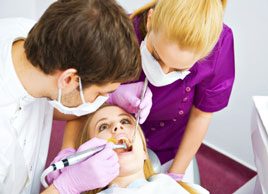What to expect at an oral cancer screening
Here’s what to expect at your next dental appointment. Plus, tips for performing an oral cancer self-check

Source: Web exclusive, November 2011
Approximately 3,200 new cases of oral cancer will be diagnosed in Canada this year and many more cases will be diagnosed with dysplasia (pre-cancer), according to the British Columbia Cancer Research Centre. Oral cancer is the sixth most common type of cancer in North America. Canadian statistics reveal that more cases of oral cancer are diagnosed in a year than cervical or ovarian cancer, and more people die from oral cancer in a year than from melanoma or cervical cancer. The good news? Approximately 84 percent of oral cancer cases may detected early by a dental professional.
Screening for oral cancer is quick and easy, with no pain or discomfort involved. It’s critical for early diagnosis and prevention. It takes less that five minutes, and can be done by your dental hygienist or dentist at your regular check-up appointment. Your dental professional will be looking for any lumps or abnormalities, red, white or grey areas and/or tenderness.
What to expect
Your dental professional should:
1. Physically examine and inspect the outside and inside of your gums and cheeks, extending all the way from top to bottom and front to back.
2. Examine and inspect the floor of your mouth underneath your tongue and the roof of your mouth.
3. Touch and inspect the lymph nodes in your neck and jaw, examine the inside and outside of your lips, your major salivary glands (cheeks and floor of mouth), as well as your jaw joint (TMJ) and the area around your ears.
4. Visually inspect your face for signs of asymmetry or swelling.
5. Pull out tongue with gauze and inspect posterior, sides, bottom and top.
6. Have you extend your tongue and say "ahhh" in order to inspect the back of your mouth and your throat
7. Ask about your smoking and/or drinking habits, your lifestyle and any specific health conditions you have or medications you are taking which could affect the condition of your mouth or head and neck area.
Some offices use a scope with a special light that will show cancerous and precancerous lesions as dark areas. "I always do a visual inspection as well," says Katherine Bell, a hygienist in Dr. Versendaal’s office in Pitt Meadows, B.C., who uses the device, called a Velscope, when conducting oral cancer examinations. "In our office we don’t charge for this service, but some offices do," says Bell, who has been practicing for 17 years.
Screenings should be done at every six month check-up. If you feel that your dental professional is not doing a thorough screening, or if they don’t do one at all, voice your concerns and ask for one. All dental hygienists and dentists are trained to do oral cancer screenings.
Performing an oral cancer self-check
If you only visit the dentist once a year or less, here’s how to perform a self-check, and what to watch for between screenings:
1. First, arm yourself with one of those handy oral mirrors available at any drugstore. You’ll be able to inspect your mouth much more easily.
2. Make sure you have a bright light. A small flashlight works well.
3. Check for any new lumps, bumps or unusual tenderness anywhere in your mouth. You can check by palpating the tissue between your thumb and forefinger, or pressing against your face from the outside (similar to checking for breast lumps). For the floor of your mouth, press beneath your tongue.
4. To check your tongue, grasp it with a gauze or cloth and extend it (the posterior is a common site for oral cancer). Say "ahhh" to check the back of your tongue and throat (you may need to ask for some help here).
5. Visually check your whole mouth, watching for any discoloured areas, or spots with unusual texture. If you check regularly, you will soon be able to differentiate between what’s normal and what’s not.
6. In general, follow as closely as possible the procedure carried out in the dental office.
7. Be aware of any sore spots in your mouth or throat that don’t heal within two weeks, or if you have difficulty swallowing. Check with your dentist or doctor right away.
If a suspicious area is found, it does not mean you have oral cancer. Only a small number of people with abnormalities will be diagnosed with oral cancer. However, all abnormal areas need further investigation to rule out precancerous or cancerous lesions. This may include a biopsy of the suspicious area.
Don’t miss out! Sign up for our free weekly newsletters and get nutritious recipes, healthy weight-loss tips, easy ways to stay in shape and all the health news you need, delivered straight to your inbox.




